Changes in the Patterns of Population Distribution and Built-Up Areas of the Rural–Urban Fringe in Post-Socialist Context—A Central European Case Study
Abstract
1. Introduction
2. Theoretical Background
2.1. Suburbanization and Urban Sprawl
2.2. Inner Suburbanization in Post-Socialist Context
2.3. Patterns and Measurement
- Infill is described as the development of a piece of land mostly surrounded by urban land cover;
- Expansion growth which has been known as urban fringe development. It is the expansion of the existing urban territory towards areas surrounded by no more than 40 percent of urban zones.
- Outlying growth is also called development beyond the urban fringe and three classes are separated within that:
- Isolated growth means formatting of urban parcels some distance from the existing developed parts—sometimes it means the construction of one building;
- Linear branch appears in the form of a new linear-like development (e.g., road, corridor) that does not attach directly to the existing urban territories;
- Clustered branch means an island-like and large development (not only isolated constructions). This type of growth is also called leapfrog or scattered development [58].
3. Materials and Methods
3.1. Study Area
3.2. Data Sources
3.3. Methods
- Expansion—newly built-up cells having a maximum of 50 percent of built-up neighboring cells (using Queen-contiguity in the definition of direct neighborhood);
- Infill—newly built-up cells having more than 50 percent of built-up neighboring cells;
- Outflying—newly built-up cells without built-up neighboring cells (leapfrog development);
- Densification—increasing object-density in the already built-up cells;
- Stagnation—stagnating object-density in the already built-up cells;
- Rarefaction—decreasing object-density in the already built-up cells;
- Emptying—disappearance of objects from previously built-up cells;
- Vacant—empty cells without objects.
4. Results and Discussion
5. Conclusions
Author Contributions
Funding
Data Availability Statement
Conflicts of Interest
References
- Knox, P. Urbanization. In International Encyclopedia of Human Geography; Kitchin, R., Thrift, N., Eds.; Elsevier Science: Oxford, UK, 2009. [Google Scholar]
- Hirt, S. Whatever happened to the (post)socialist city? Cities 2013, 32, 29–38. [Google Scholar] [CrossRef]
- Sailer-Fliege, U. Characteristics of post-socialist urban transformation in East Central Europe. GeoJournal 1999, 49, 7–16. [Google Scholar] [CrossRef]
- Stanilov, K.; Sýkora, L. Confronting Suburbanization: Urban Decentralization in Postsocialist Central and Eastern Europe; John Wiley & Sons: New York, NY, USA, 2014. [Google Scholar]
- Hirt, S. Suburbanizing Sofia: Characteristics of post-socialist peri-Urban change. Urban Geogr. 2007, 28, 755–780. [Google Scholar] [CrossRef]
- Matlovičová, K.; Kormaníková, J. City Brand-Image Associations Detection. Case Study of Prague. In SGEM International Multidisciplinary Scientific Conferences on Social Sciences and Arts, Proceedings of the SGEM 2014, Psychology & Psychiatry, Sociology & Healthcare, Education, Albena, Bulgaria, 2–7 September 2014; Conference Proceedings, Sociology and Healthcare; Bulgarian Academy of Sciences: Albena, Bulgaria, 2014; Volume II, pp. 139–146. [Google Scholar]
- Ianos, I.; Sîrodoev, I.; Pascariu, G.; Henebry, G. Divergent patterns of built-up urban space growth following post-socialist changes. Urban Stud. 2016, 53, 3172–3188. [Google Scholar] [CrossRef]
- Kovács, Z.; Farkas, J.Z.; Egedy, T.; Kondor, A.C.; Szabó, B.; Lennert, J.; Baka, D.; Kohán, B. Urban sprawl and land conversion in post-socialist cities: The case of metropolitan Budapest. Cities 2019, 92, 71–81. [Google Scholar] [CrossRef]
- Slaev, A.D.; Nedović-Budić, Z.; Krunić, N.; Petrić, J.; Daskalova, D. Suburbanisation and sprawl in post-socialist Belgrade and Sofia. Eur. Plan. Stud. 2018, 26, 1389–1412. [Google Scholar] [CrossRef]
- Havryliuk, O.; Gnatiuk, O.; Mezentsev, K. Suburbanization, but centralization? Migration patterns in the post-Soviet functional urban region—Evidence from Kyiv. Folia Geogr. 2021, 63, 64–84. [Google Scholar]
- Zévl, J.-J.; Ouředníček, M. Measuring the morphology of suburban settlements: Scale-dependent ambiguities of residential density development in the Prague urban region. Morav. Geogr. Rep. 2021, 29, 27–38. [Google Scholar] [CrossRef]
- Matlovič, R.; Sedláková, A. The impact of suburbanisation in the hinterland of Prešov. Morav. Geogr. Rep. 2007, 15, 22–31. [Google Scholar]
- Dinić Branković, M.; Bogdanović Protić, I.; Djekić, J.; Mitković, P. Post-socialist suburbanization and sprawl development patterns—Niš, case study. Facta Univ.—Ser. Archit. Civ. Eng. 2016, 14, 355–366. [Google Scholar] [CrossRef]
- Hardi, T.; Repaská, G.; Veselovský, J.; Vilinová, K. Environmental consequences of the urban sprawl in the suburban zone of Nitra: An analysis based on landcover data. Geogr. Pannonica 2020, 24, 205–220. [Google Scholar] [CrossRef]
- Spórna, T.; Krzysztofik, R. ‘Inner’ suburbanization. Background of the phenomenon in a polycentric, post-socialist and post-industrial region. Example from the Katowice conurbation, Poland. Cities 2020, 104, 102789. [Google Scholar] [CrossRef]
- Szmytkie, R. Suburbanisation processes within and outside the city: The development of intra-urban suburbs in Wrocław, Poland. Morav. Geogr. Rep. 2021, 29, 149–165. [Google Scholar] [CrossRef]
- Kubeš, J. European post-socialist cities and their near hinterland in intra-urban geography literature. Bull. Geogr. Socio-Econ. Ser. 2013, 19, 19–43. [Google Scholar] [CrossRef][Green Version]
- Bajmócy, P. A szuburbanizáció két évtizede Magyarországon (Two decades of the suburbanization in Hungary). Észak-Magyarországi Strat. Füzetek 2014, 11, 6–17. [Google Scholar]
- Taubenböck, H.; Rusche, K.; Siedentop, S.; Wurm, M. Patterns of Eastern European urbanisation in the mirror of Western trends—Convergent, unique or hybrid? Environ. Plan. B Urban Anal. City Sci. 2019, 46, 1206–1225. [Google Scholar] [CrossRef]
- Peiser, R. Decomposing urban sprawl. Town Plan. Rev. 2001, 72, 275–298. [Google Scholar] [CrossRef]
- Bujdosó, Z.; Gyurkó, Á.; Hágen, I. Socio-economic aspects of the urbanisation in Northern Hungary in the 21st century. Folia Geogr. 2016, 58, 35–53. [Google Scholar]
- Miljanović, D.; Vuksanović-Macura, Z.; Doljak, D. Rethinking the spatial transformation of postsocialist cities: Shrinking, sprawling or densifying. Cities 2023, 140, 104443. [Google Scholar] [CrossRef]
- Enyedi, G. The stages of urban growth. In Urban Sprawl in Europe: Similarities or Differences? Szirmai, V., Ed.; Aula Publisher: Budapest, Hungary, 2011; pp. 45–63. [Google Scholar]
- Nagy, G.; Hegedűs, T. Urban sprawl or/and suburbanisation? The case of Zalaegerszeg. Belvedere Meridionale 2016, 28, 106–119. [Google Scholar] [CrossRef]
- Timár, J. The main features of suburbanization in the Great Hungarian Plain. Landsc. Urban Plan. 1993, 22, 177–187. [Google Scholar] [CrossRef]
- Unger, J.; Gál, T.M.; Rakonczai, J.; Mucsi, L.; Szatmári, J.; Tobak, Z.; van Leeuwen, B.; Fiala, K. Modeling of the urban heat island pattern based on the relationship between surface and air temperatures. Időjárás Q. J. Hung. Meteorol. Serv. 2010, 114, 287–302. [Google Scholar]
- Kovács, Z.; Farkas, J.Z.; Szigeti, C.; Harangozó, G. Assessing the sustainability of urbanization at the sub-national level: The ecological footprint and biocapacity accounts of the Budapest metropolitan region, Hungary. Sustain. Cities Soc. 2022, 84, 104022. [Google Scholar] [CrossRef]
- Csorba, P.; Bánóczki, K.; Túri, Z. Land use changes in peri-urban open spaces of small towns in Eastern Hungary. Sustainability 2022, 14, 10680. [Google Scholar] [CrossRef]
- Mocák, P.; Matlovičová, K.; Matlovič, R.; Pénzes, J.; Pachura, P.; Mishra, K.P.; Kostilníková, K.; Demková, M. 15-minute city concept as a sustainable urban development alternative: A brief outline of conceptual frameworks and Slovak cities as a case. Folia Geogr. 2022, 64, 69–89. [Google Scholar]
- Audirac, I. Shrinking cities: An unfit term for American urban policy? Cities 2018, 75, 12–19. [Google Scholar] [CrossRef]
- Trócsányi, A.; Pirisi, G.; Máté, É. An interpretation attempt of Hungarian small towns’ shrinking in a post-socialist transformation context. Chasopys Soc.-Econ. Heohr. J. Hum. Geogr. 2018, 24, 5–20. [Google Scholar] [CrossRef]
- Sarzynski, A.; Vicina, T.J. Shrinking Suburbs: Analyzing the Decline of American Suburban Spaces. Sustainability 2019, 11, 5230. [Google Scholar] [CrossRef]
- Burdack, J.; Dövényi, Z.; Kovács, Z. Am Rand von Budapest—Die Metropolitane Peripherie zwischen nachholender Entwicklung und eigenem Weg. Petermanns Geogr. Mitteilungen 2004, 148, 30–39. [Google Scholar]
- Brezdeń, P.; Szmytkie, R. Current Changes in the Location of Industry in the Suburban Zone of a Post-Socialist City: Case Study of Wrocław (Poland). Tijdschr. Voor Econ. En Soc. Geogr. 2018, 110, 102–122. [Google Scholar] [CrossRef]
- Feng, C.; Zhang, H.; Xiao, L.; Guo, Y. Land use change and its driving factors in the rural–urban fringe of Beijing: A production–living–ecological perspective. Land 2022, 11, 314. [Google Scholar] [CrossRef]
- Csatári, B.; Farkas, J.Z.; Lennert, J. Land use changes in the rural-urban fringe of Kecskemét after the economic transition. J. Settl. Spat. Plan. 2013, 4, 153–159. [Google Scholar]
- Lityński, P. The intensity of urban sprawl in Poland. ISPRS Int. J. Geo-Inf. 2021, 10, 95. [Google Scholar] [CrossRef]
- Sýkora, L.; Bouzarovski, S. Multiple transformations: Conceptualising the post-communist urban transition. Urban Stud. 2012, 49, 43–60. [Google Scholar] [CrossRef]
- Kubeš, J.; Nováček, A. Suburbs around the Czech provincial city of České Budějovice—Territorial arrangement and problems. Hung. Geogr. Bull. 2019, 68, 65–78. [Google Scholar] [CrossRef]
- Leetmaa, K.; Brade, I.; Anniste, K.; Nuga, M. Socialist summer-home settlements in post-socialist suburbanisation. Urban Stud. 2012, 49, 3–21. [Google Scholar] [CrossRef]
- Vasárus, G.L.; Lennert, J. Suburbanization within City Limits in Hungary—A Challenge for Environmental and Social Sustainability. Sustainability 2022, 14, 8855. [Google Scholar] [CrossRef]
- Vasárus, G.; Bajmócy, P.; Lennert, J. In the shadow of the city: Demographic processes and emerging conflicts in the rural-urban fringe of the Hungarian agglomerations. Geogr. Pannonica 2018, 22, 14–29. [Google Scholar] [CrossRef]
- Pócsi, G. Land use change of the ‘Small Hobby Gardens’ in the peri-urban area of Szeged, Hungary. Forum Geogr. 2011, 10, 312–321. [Google Scholar] [CrossRef]
- Beluszky, P.; Timár, J. The changing political system and urban restructuring in Hungary. Tijdschr. Voor Econ. En Soc. Geogr. 1992, 83, 380–389. [Google Scholar] [CrossRef]
- Brunn, S.D.; Matlovičová, K.; Mušinka, A.; Matlovič, R. Policy implications of the vagaries in population estimates on the accuracy of sociographical mapping of contemporary Slovak Roma communities. GeoJournal 2018, 83, 853–869. [Google Scholar] [CrossRef]
- Vasárus, G.L. Városhatáron belüli szuburbanizáció Magyarországon—Egy paradoxon feltárása (Suburbanisation within the city in Hungary—Exploring a paradox). Területi Stat. 2022, 62, 379–404. [Google Scholar] [CrossRef]
- Timár, J.; Váradi, M.M. The uneven development of suburbanization during transition in Hungary. Eur. Urban Reg. Stud. 2001, 8, 349–360. [Google Scholar] [CrossRef]
- Kristóf, A. The Impact of Suburbanization on Social Differentiation in Hungary: A case study of the Miskolc agglomeration. Geogr. Pannonica 2018, 22, 176–188. [Google Scholar] [CrossRef]
- Oşlobanu, C.; Alexe, M. Built-up area analysis using sentinel data in metropolitan areas of Transylvania, Romania. Hung. Geogr. Bull. 2021, 70, 3–18. [Google Scholar] [CrossRef]
- Szabó, L.; Abriha, D.; Phinzi, K.; Szabó, S. Urban vegetation classification with high-resolution PlanetScope and SkySat multispectral imagery. Acta Geogr. Debrecina Landsc. Environ. Ser. 2021, 15, 66–75. [Google Scholar] [CrossRef]
- Mucsi, L.; Liska, C.M.; Henits, L.; Tobak, Z.; Csendes, B.; Nagy, L. The evaluation and application of an urban land cover map with image data fusion and laboratory measurements. Hung. Geogr. Bull. 2017, 66, 145–156. [Google Scholar] [CrossRef]
- Diaz-Pacheco, J.; Gutiérrez, J. Exploring the limitations of CORINE Land Cover for monitoring urban land-use dynamics in metropolitan areas. J. Land Use Sci. 2014, 9, 243–259. [Google Scholar] [CrossRef]
- Cieślak, I.; Biłozor, A.; Szuniewicz, K. The Use of the CORINE Land Cover (CLC) Database for Analyzing Urban Sprawl. Remote Sens. 2020, 12, 282. [Google Scholar] [CrossRef]
- Izakovičová, Z.; Petrovič, F.; Pauditšová, E. The Impacts of Urbanisation on Landscape and Environment: The Case of Slovakia. Sustainability 2021, 14, 60. [Google Scholar] [CrossRef]
- Kolcsár, R.A.; Csikós, N.; Szilassi, P. Testing the limitations of buffer zones and Urban atlas population data in urban green space provision analyses through the case study of Szeged, Hungary. Urban For. Urban Green. 2021, 57, 126942. [Google Scholar] [CrossRef]
- Tikoudis, I.; Farrow, K.; Mebiame, R.M.; Oueslati, W. Beyond average population density: Measuring sprawl with density-allocation indicators. Land Use Policy 2022, 112, 105832. [Google Scholar] [CrossRef]
- Gerten, C.; Boyko, D.; Fina, S. Patterns of post-socialist urban development in Russia and Germany. Front. Sustain. Cities 2022, 4, 846956. [Google Scholar] [CrossRef]
- Wilson, E.H.; Hurd, J.D.; Civco, D.L.; Prisloe, M.P.; Arnold, C. Development of a geospatial model to quantify, describe and map urban growth. Remote Sens. Environ. 2003, 86, 275–285. [Google Scholar] [CrossRef]
- Forman, R.T.T. Land Mosaics: The Ecology of Landsapces and Regions; Cambridge University Press: Cambridge, UK, 1995. [Google Scholar]
- Gyenizse, P.; Bognár, Z.; Czigány, S.; Elekes, T. Landscape shape index, as a potential indicator of urban development in Hungary. Acta Geogr. Debrecina Landsc. Environ. 2014, 8, 78–88. [Google Scholar]
- Jiang, G.; Ma, W.; Qu, Y.; Zhang, R.; Zhou, D. How does sprawl differ across urban built-up land types in China? A spatial-temporal analysis of the Beijing metropolitan area using granted land parcel data. Cities 2016, 58, 1–9. [Google Scholar] [CrossRef]
- Süli-Zakar, I. Debrecen gazdaságának és településszerkezetének történeti-földrajza (Historical geography of the economy and settlement structure of Debrecen). In Tanulmányok Debrecen Városföldrajzából II; Süli-Zakar, I., Ed.; Kossuth Lajos Tudományegyetem Társadalomföldrajzi Tanszék: Debrecen, Hungary, 1996; pp. 149–267. [Google Scholar]
- Molnár, E.; Dézsi, G.; Lengyel, I.M.; Kozma, G. Vidéki nagyvárosaink gazdaságának összehasonlító elemzése (A comparative analysis of the Hungarian minor cities). Területi Stat. 2018, 58, 610–637. [Google Scholar] [CrossRef]
- Hegedűs, L.D.; Túri, Z.; Apáti, N.; Pénzes, J. Analysis of the intra-urban suburbanization with GIS methods—The case of Debrecen since the 1980s. Folia Geogr. 2023, 65, 23–39. [Google Scholar]
- Kozma, G. A Debreceni Lakóterületek II. Világháború Utáni Fejlődésének Társadalomföldrajzi Vizsgálata (Social Geographical Analysis of the Development of Residential Areas in Debrecen after WWII); Didakt Kiadó: Debrecen, Hungary, 2016. [Google Scholar]
- Hungarian Central Statistical Office (HCSO). Helységnévtár (Detailed Gazetteer). Available online: https://www.ksh.hu/apps/hntr.telepules?p_lang=HU&p_id=15130 (accessed on 21 August 2021).
- GeoX Ltd. (Budapest, Hungary). Available online: https://geox.hu/terinformatikai-uzleti-megoldasok/uzleti-adatbazisok/100x100-geo-demografiai-terkep/ (accessed on 17 August 2021).
- Sándor, G.; Szabó, G.; Charzyński, P.; Szynkowska, E.; Novák, T.J.; Świtoniak, M. Technogenic soils in Debrecen. In Technogenic Soil Atlas; Charzyński, P., Markiewicz, M., Świtoniak, M., Eds.; Polish Society of Soil Science: Torun, Poland, 2013; pp. 35–74. [Google Scholar]
- Balogh, S.; Novák, T.J. Trends and hotspots in landscape transformation based on anthropogenic impacts on soil in Hungary, 1990–2018. Hung. Geogr. Bull. 2020, 69, 349–361. [Google Scholar] [CrossRef]
- Csorba, P.; Ádám, S.; Bartos-Elekes, Z.; Bata, T.; Bede-Fazekas, Á.; Czúcz, B.; Csima, P.; Csüllög, G.; Fodor, N.; Frisnyák, S.; et al. Landscapes. In National Atlas of Hungary—Natural Environment, 1st ed.; Kocsis, K., Gercsák, G., Horváth, G., Keresztesi, Z., Nemerkényi, Z., Eds.; MTA CSFK Geographical Institute: Budapest, Hungary, 2018; pp. 112–129. [Google Scholar]
- Csomós, G.; Farkas, J.Z.; Kovács, Z. Access to urban green spaces and environmental inequality in post-socialist cities. Hung. Geogr. Bull. 2020, 69, 191–207. [Google Scholar] [CrossRef]
- Lechner Knowledge Center Non-Profit Limited Company. Topographic Maps in Scale 1:10,000 (Map Sheet Numbers: 69–121, 69–122, 69–123, 69–124, 69–141, 69–142, 69–144, 69–211, 69–212, 69–213, 69–214, 69–221, 69–222, 69–223, 69–224, 69–231, 69–232, 69–233, 69–234, 69–241, 69–242, 69–243, 69–244, 69–322, 69–324, 69–411, 69–412, 69–413, 69–414, 69–421, 69–422, 69–423, 79–433, 79–434). 1978–1987. Available online: https://geoshop.hu (accessed on 19 February 2023).
- Hungarian Institute of Geodesy, Cartography and Remote Sensing. Colour Orthophotos of Hungary. 2000. Available online: https://qms.nextgis.com/geoservices/900/ (accessed on 13 March 2023).
- Google Satellite Hybrid WMS. Satellite Imagery Covering Debrecen from September 2019 and May–June 2020. Available online: https://mt1.google.com/vt/lyrs=y&x={x}&y={y}&z={z} (accessed on 13 March 2023).
- OpenStreetMap (OSM). Available online: https://www.openstreetmap.org (accessed on 22 February 2023).
- Local Authority of Debrecen (Maintained by the ERDA Kft. Company). Available online: https://debrecen.erda.hu/ (accessed on 27 August 2021).
- Jakobi, Á. A grid: Aggregált és dezaggregált rácsmodellek a területi egyenlőtlenségek vizsgálatában (Aggregated and disaggregated grid models in the investigation of spatial inequalities). Területi Stat. 2015, 55, 322–338. [Google Scholar]
- de Smet, F.; Teller, J. Characterising the morphology of suburban settlements: A method based on a semi-automatic classification of building clusters. Landsc. Res. 2016, 41, 113–136. [Google Scholar] [CrossRef]
- Netrdová, P.; Nosek, V.; Hurbánek, P. Using areal interpolation to deal with differing regional structures in international research. ISPRS Int. J. GeoInf. 2020, 9, 126. [Google Scholar] [CrossRef]
- Papp, I.; Pénzes, J.; Demeter, G. A közlekedési hálózatok és a komplex területi fejlettség időbeli összehasonlító vizsgálata a történelmi Magyarország példáján (Comparative temporal analysis of transportation networks and complex territorial development through the example of historical Hungary). Területi Stat. 2021, 61, 445–465. [Google Scholar] [CrossRef]
- Demeter, G.; Papp, I.; Romhányi, B.F.; Pénzes, J. A területi egyenlőtlenségek településszintű vizsgálata a történeti Magyarország és utódállamai területén, 1330–2010 (I.) (Long-term study of territorial inequalities at settlement level in the territory of the historical Hungary and its successor states, 1330–2010 (I.)). Területi Stat. 2023, 63, 271–299. [Google Scholar] [CrossRef]
- Copernicus Land Monitoring Service. Corine Land Cover Change 1990–2000. Available online: https://land.copernicus.eu/pan-european/corine-land-cover/lcc-1990-2000 (accessed on 10 May 2023).
- Copernicus Land Monitoring Service. Corine Land Cover Change 2000–2006. Available online: https://land.copernicus.eu/pan-european/corine-land-cover/lcc-2000-2006 (accessed on 10 May 2023).
- Copernicus Land Monitoring Service. Corine Land Cover Change 2006–2012. Available online: https://land.copernicus.eu/pan-european/corine-land-cover/lcc-2006-2012 (accessed on 10 May 2023).
- Copernicus Land Monitoring Service. Corine Land Cover Change 2012–2018. Available online: https://land.copernicus.eu/pan-european/corine-land-cover/lcc-2012-2018 (accessed on 10 May 2023).
- Copernicus Land Monitoring Service. Corine Land Cover. Available online: https://land.copernicus.eu/pan-european/corine-land-cover (accessed on 10 May 2023).
- Büttner, G.; Kosztra, B.; Maucha, G.; Pataki, R.; Kleeschulte, S.; Hazeu, G.W.; Vittek, M.; Schroder, C.; Littkopf, A. Copernicus Land Monitoring Service—CORINE Land Cover. User Manual. European Environment Agency (p. 128). 2021. Available online: https://land.copernicus.eu/user-corner/technical-library/clc-product-user-manual (accessed on 10 May 2023).
- Mari, L.; Mattányi, Z. Egységes európai felszínborítási adatbázis a CORINE Land Cover program (A Uniform European Land Cover Database and and the CORINE Land Cover Program). Földrajzi Közlemények 2002, 126, 31–38. [Google Scholar]
- Anderson, T.K. Kernel density estimation and K-means clustering to profile road accident hotspots. Accid. Anal. Prev. 2009, 41, 359–364. [Google Scholar] [CrossRef]
- Caine, I.; Walter, R.; Foote, N. San Antonio 360: The rise and decline of the concentric city 1890–2010. Sustainability 2017, 9, 649. [Google Scholar] [CrossRef]
- Zhu, H.; Ou, X.; Yang, Z.; Yang, Y.; Ren, H.; Tang, L. Spatiotemporal dynamics and driving forces of land urbanization in the Yangtze river delta urban agglomeration. Land 2022, 11, 1365. [Google Scholar] [CrossRef]
- Zhang, J.; We, D.; Zhu, A.-X.; Zhu, Y. Modelling urban expansion with cellular automata supported by urban growth intensity over time. Ann. GIS 2023, 29, 337–353. [Google Scholar] [CrossRef]
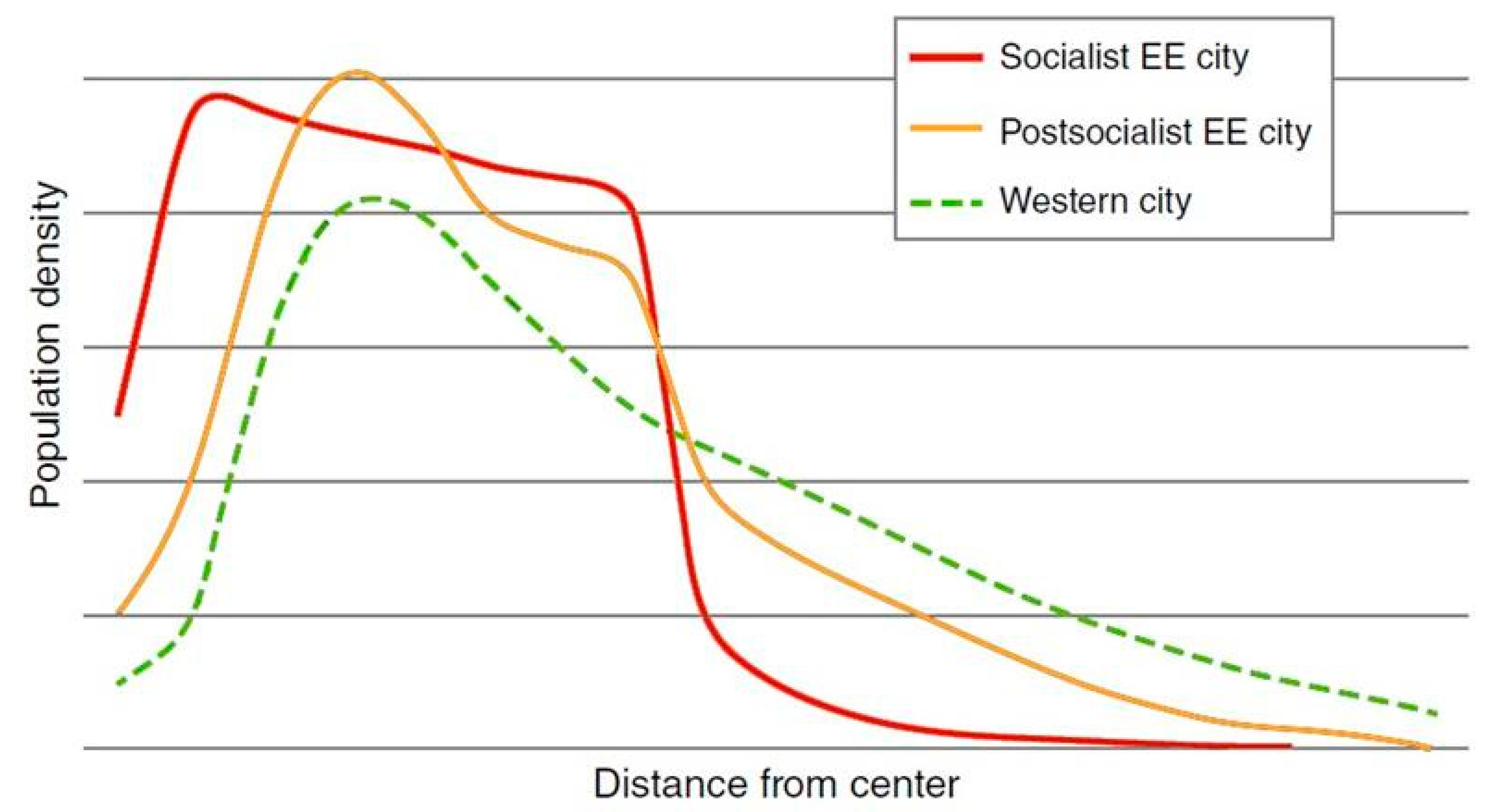
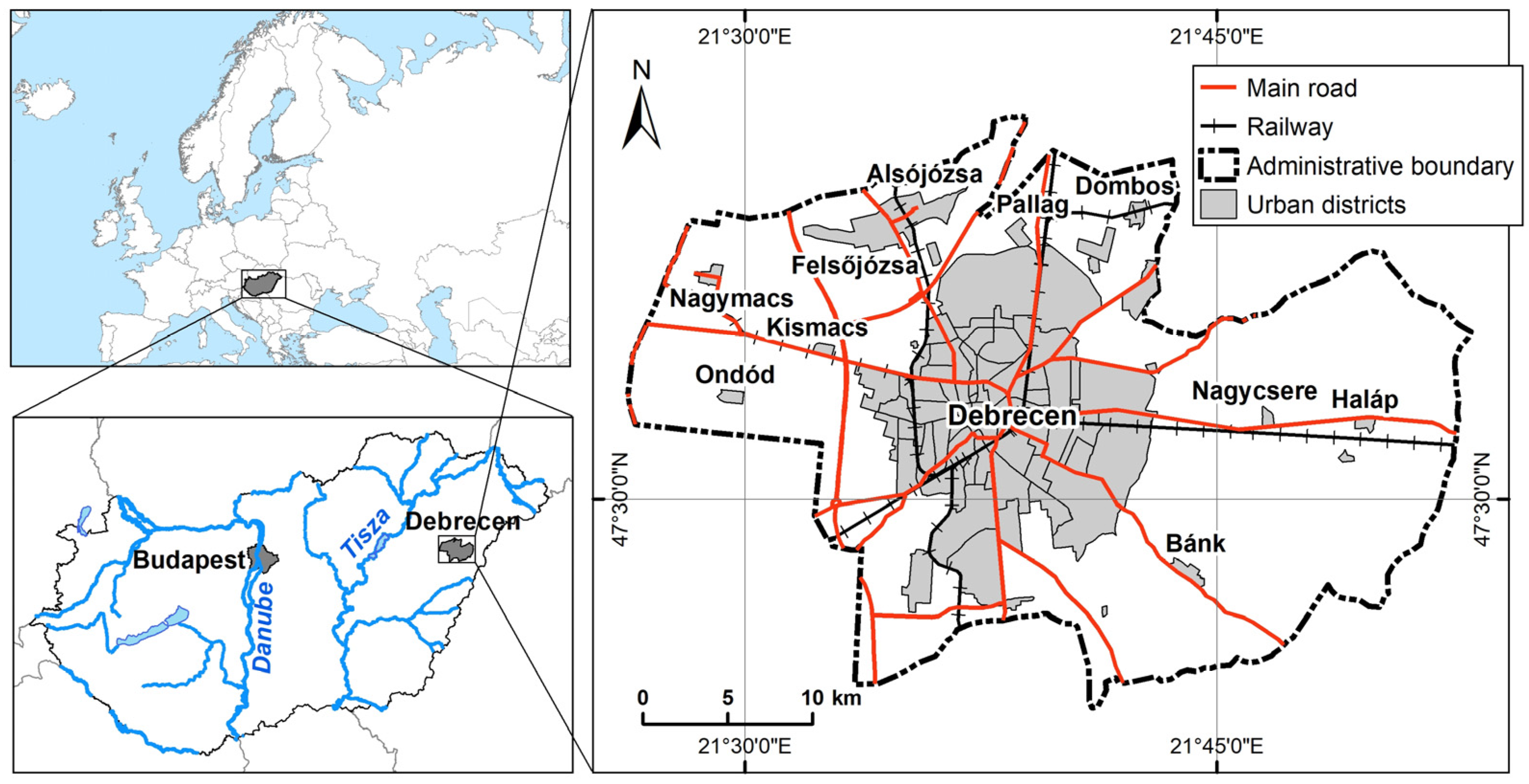
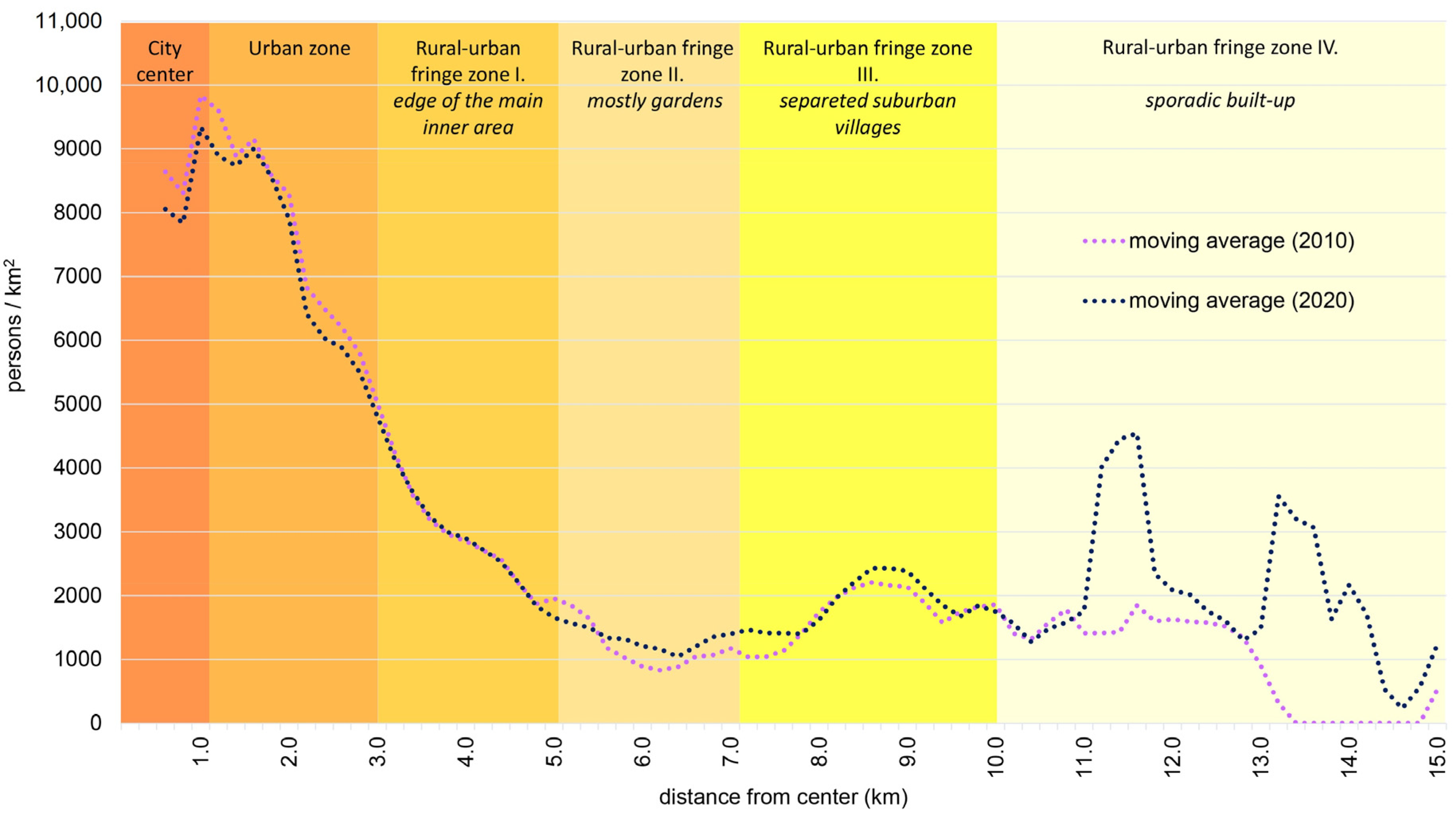
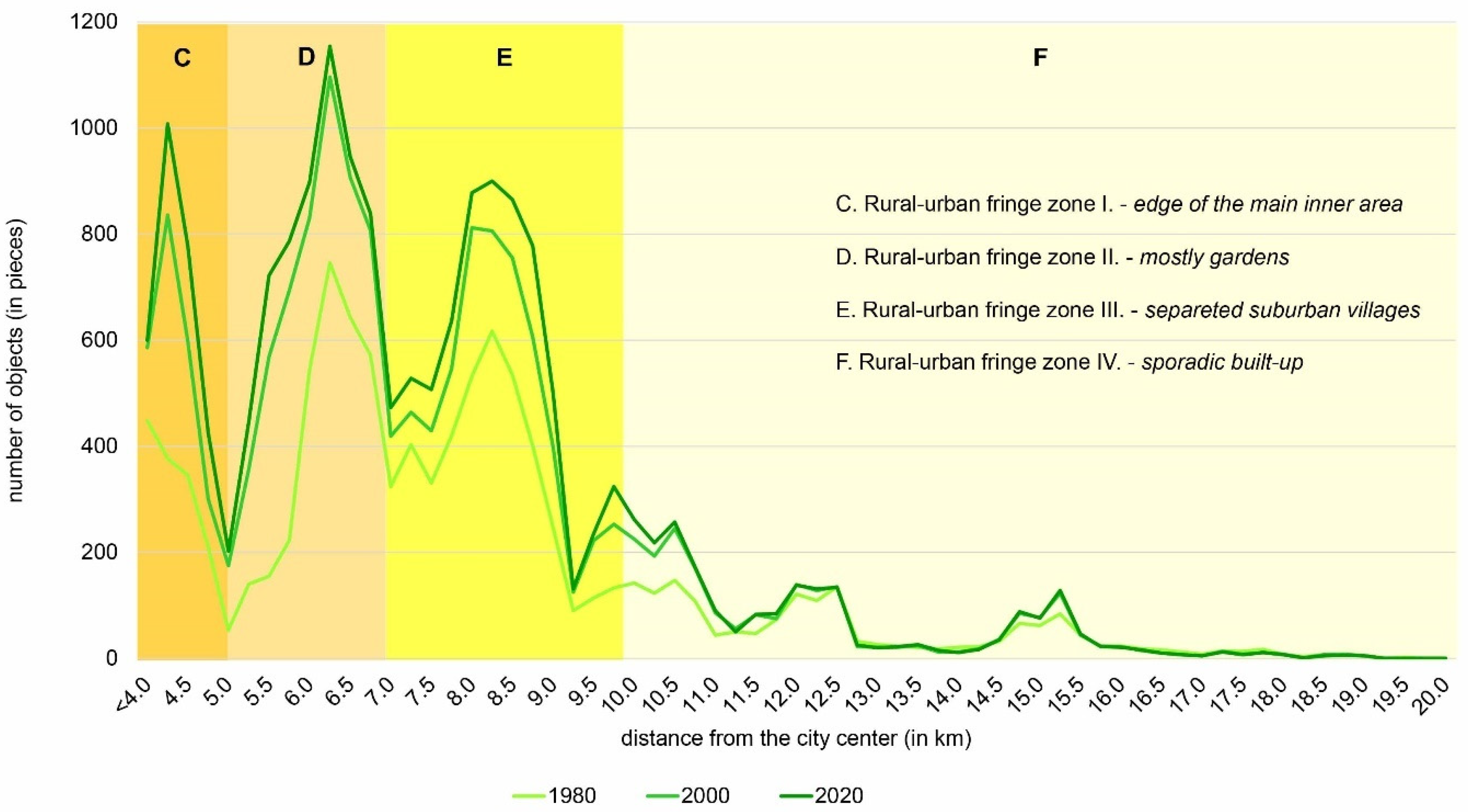
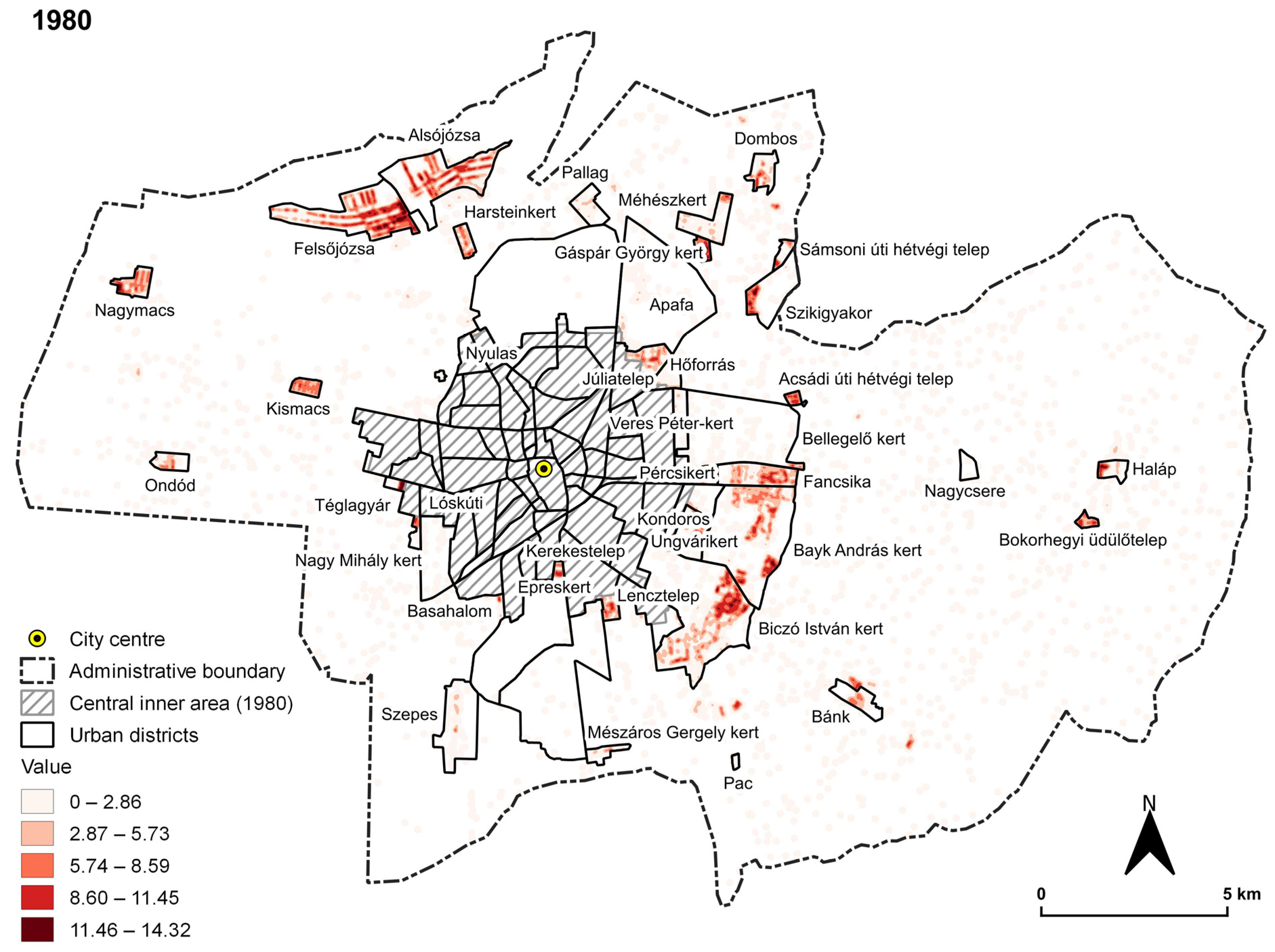
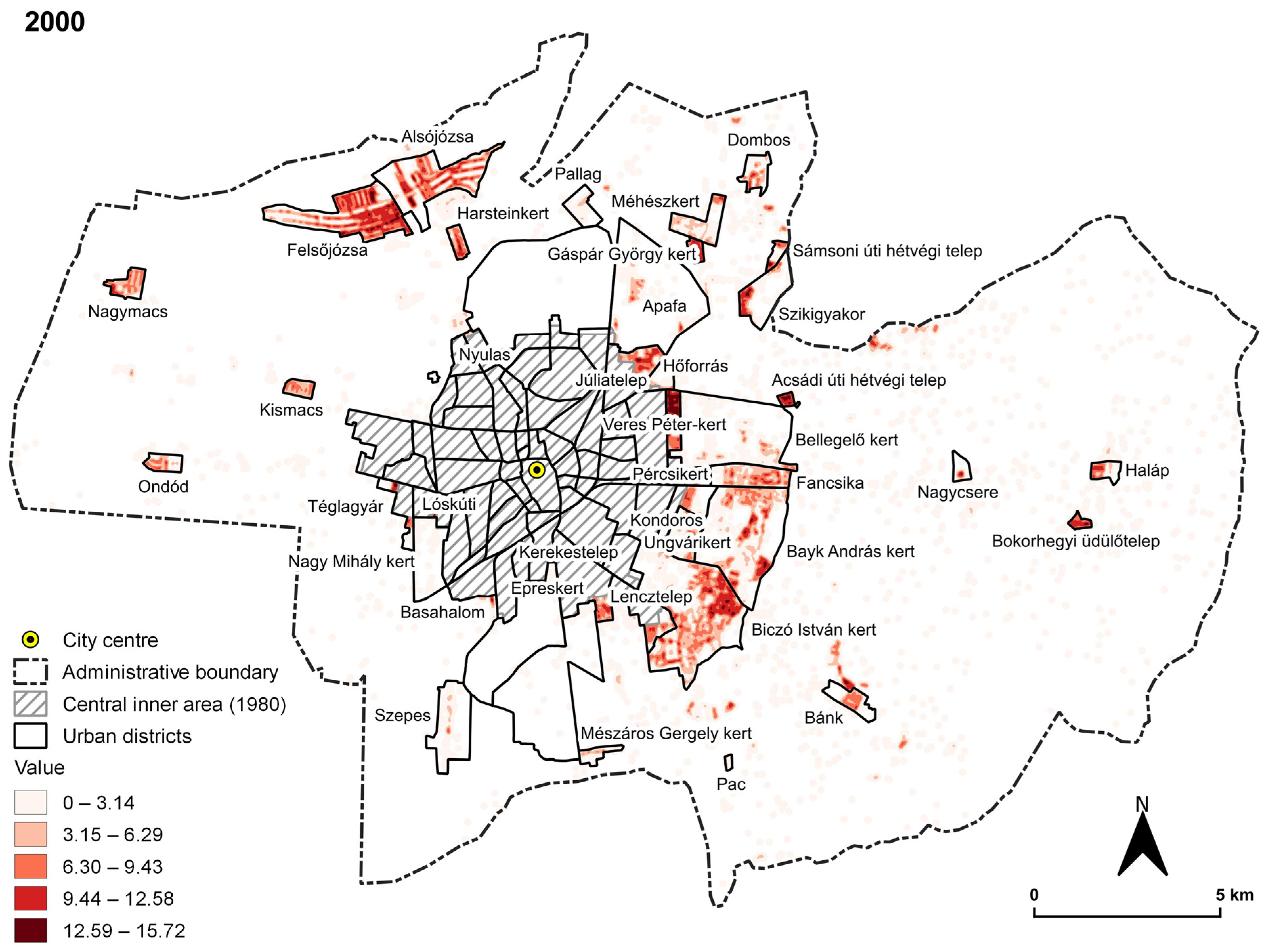
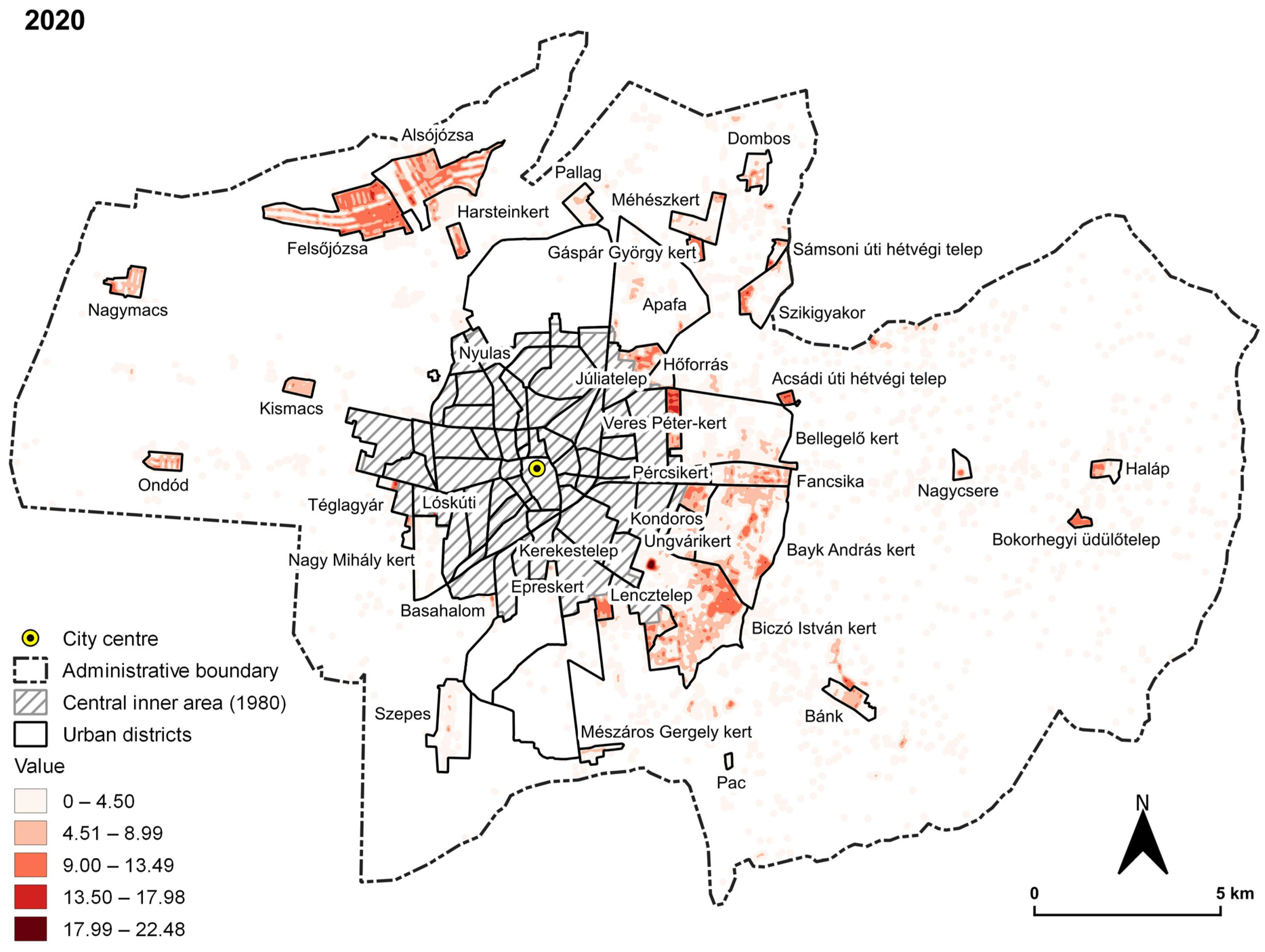
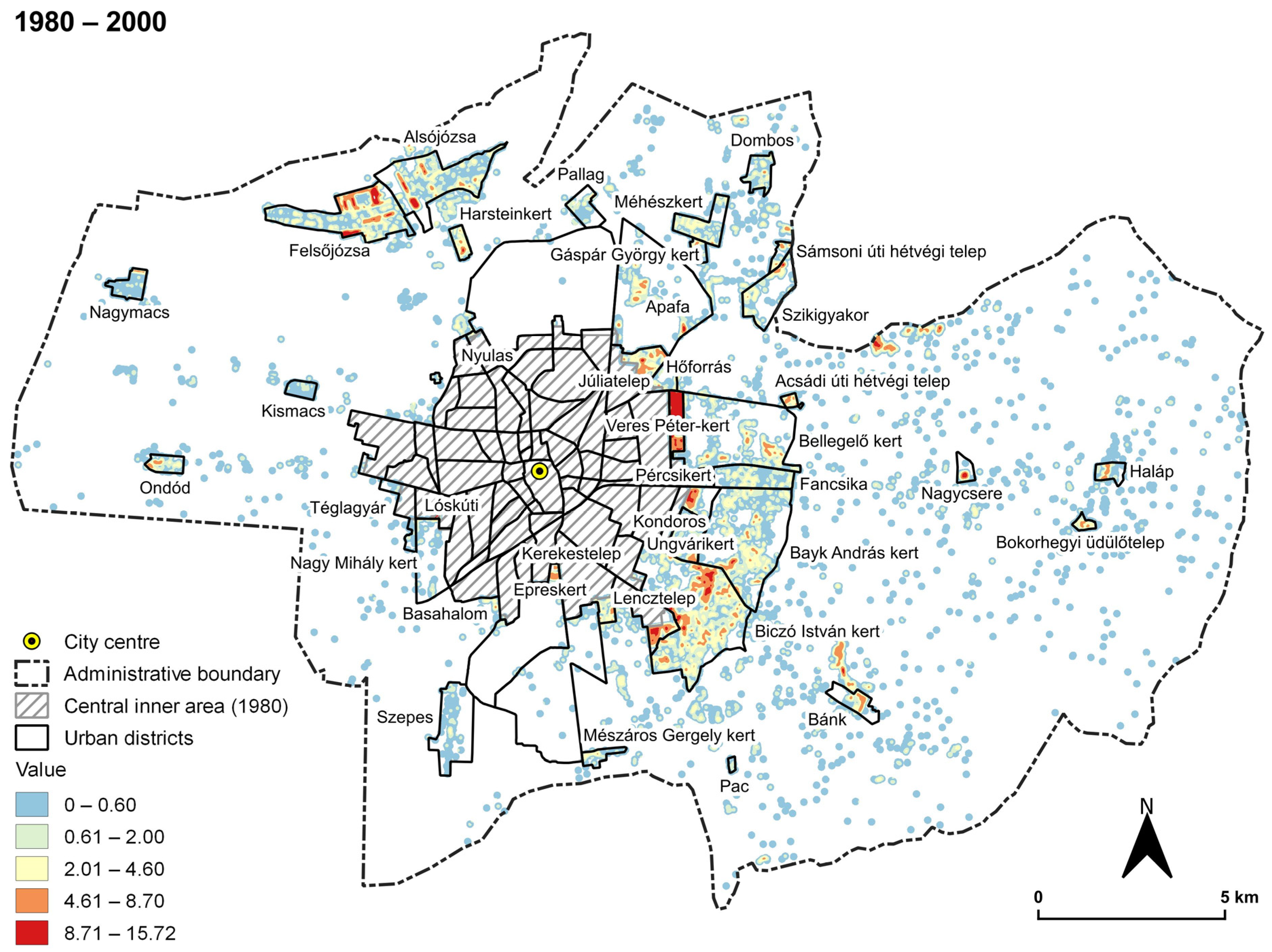
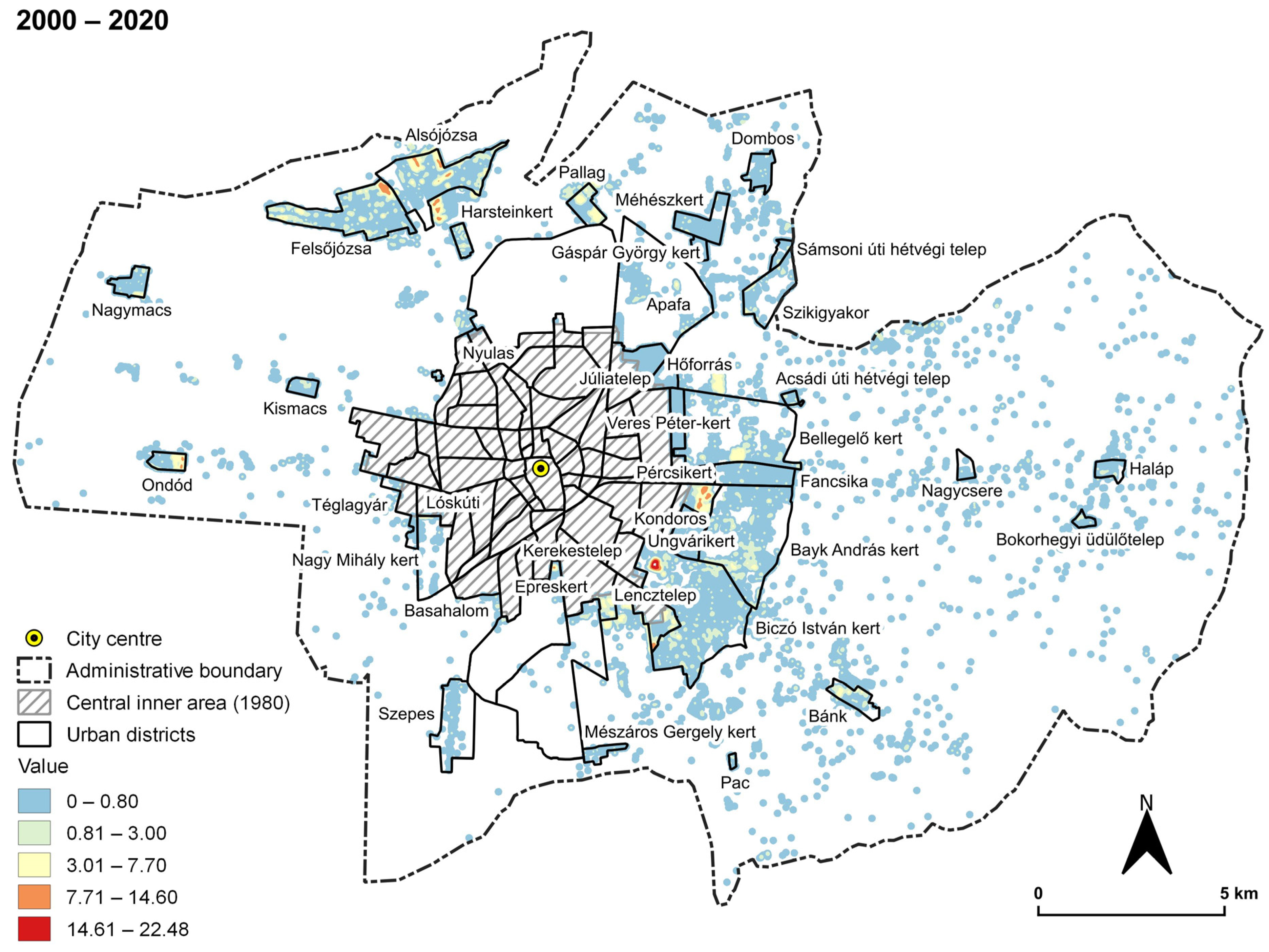
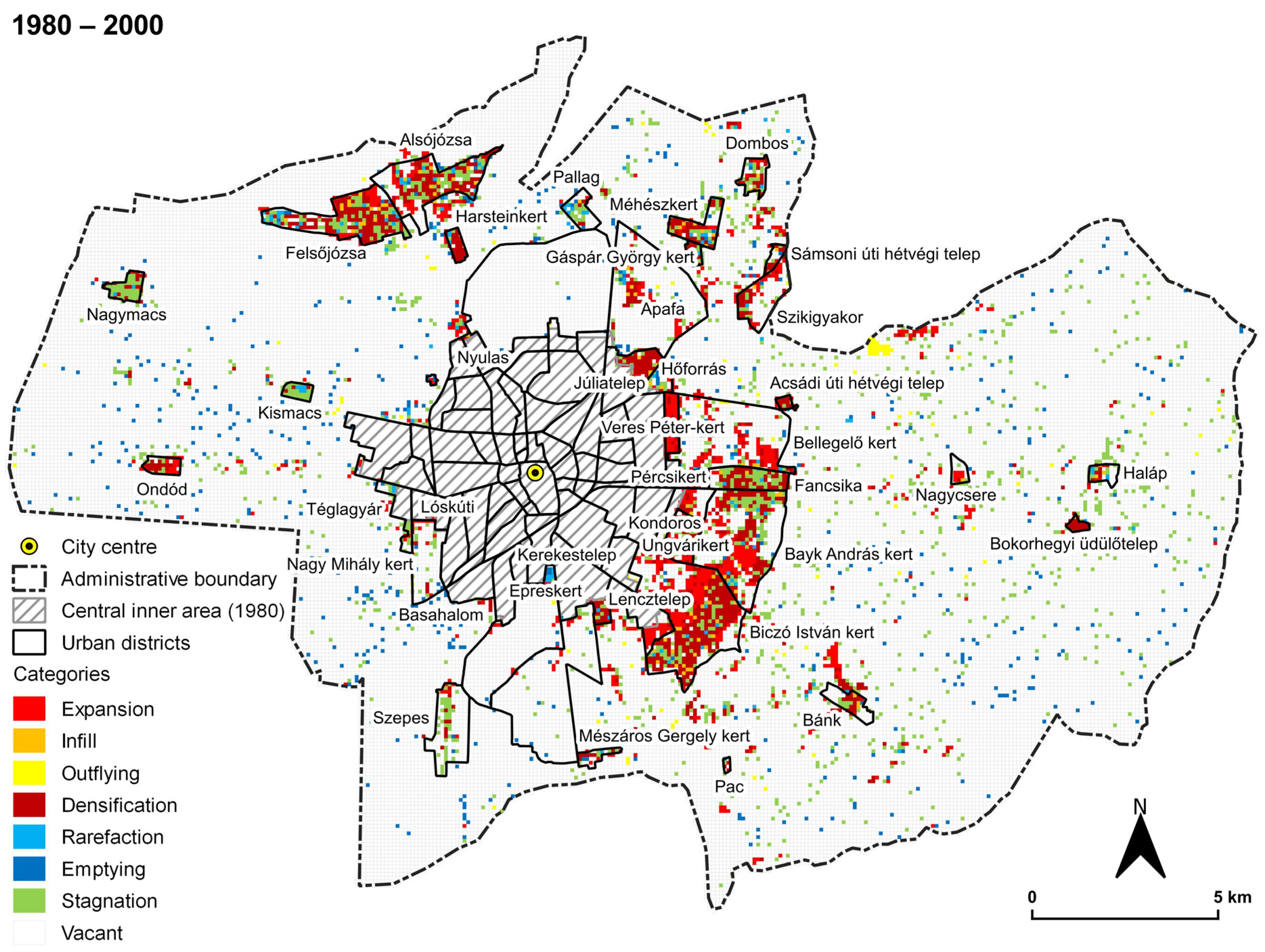
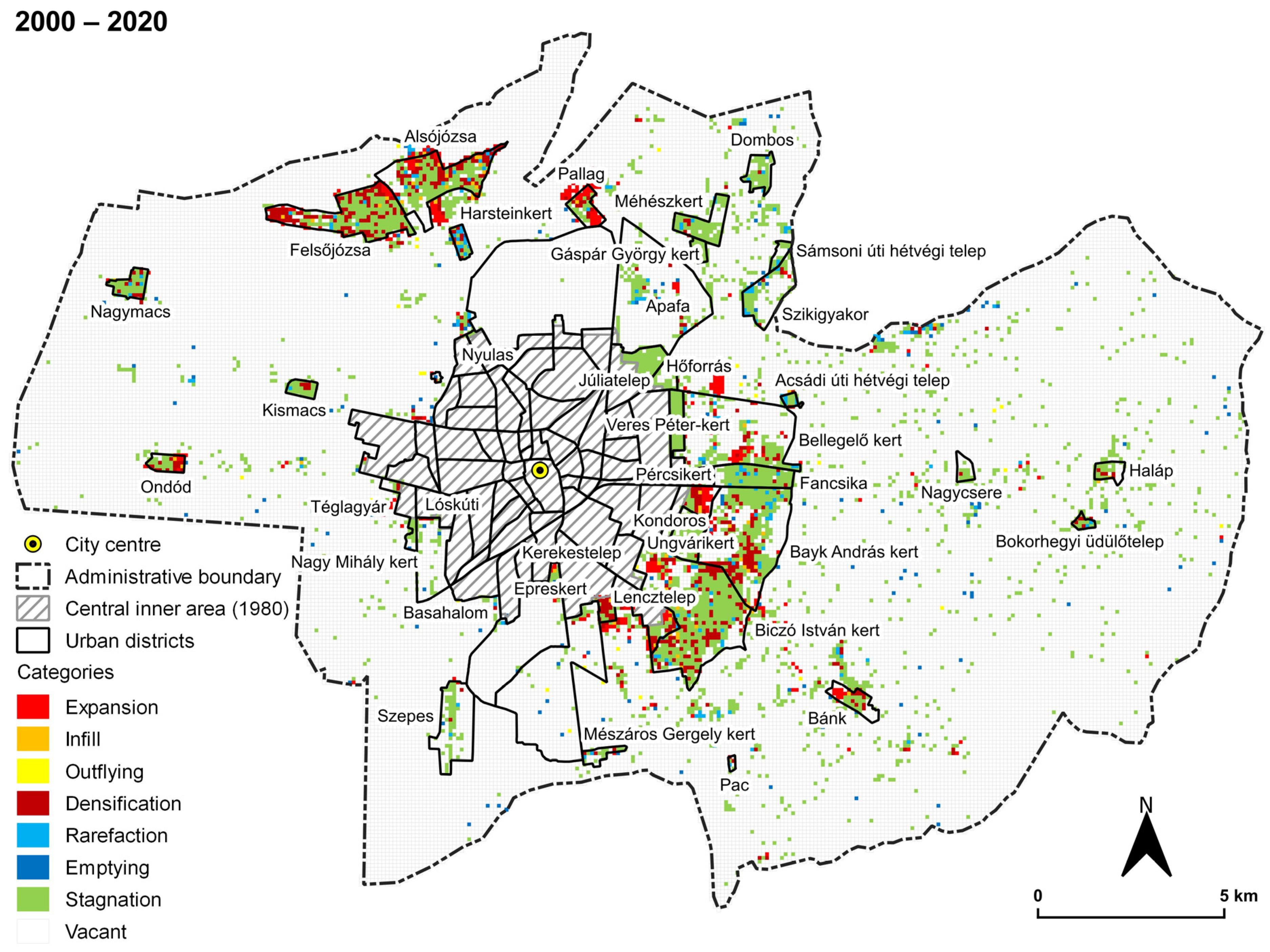
| Number of Residents, Capita | Change, Percentage | ||||||||
|---|---|---|---|---|---|---|---|---|---|
| Areas | 1980 | 1990 | 2001 | 2011 | 2020 * | 1980–1990 | 1990–2001 | 2001–2011 | 2011–2020 |
| Central inner area | 180,372 | 195,414 | 188,924 | 181,859 | 166,289 | 8.3 | −3.3 | −3.7 | −8.6 |
| Other inner areas | 9606 | 10,362 | 13,745 | 15,137 | 17,347 | 7.9 | 32.6 | 10.1 | 14.6 |
| from which Józsa ** | 6701 | 7293 | 9541 | 10,944 | 11,886 | 8.8 | 30.8 | 14.7 | 8.6 |
| Outskirts | 8217 | 6459 | 7686 | 14,127 | 15,651 | −21.4 | 19.0 | 83.8 | 10.8 |
| Debrecen together | 198,195 | 212,235 | 210,355 | 211,123 | 199,287 | 7.1 | −0.9 | 0.4 | −5.6 |
| Corine LC/LU before Change | Corine LC/LU after Change |
|---|---|
| 133 Construction sites 141 Green urban areas 211 Non-irrigated arable land 231 Pastures 242 Complex cultivation patterns | 111 Continuous urban fabric |
| 112 Discontinuous urban fabric 141 Green urban areas | |
| 142 Sport and leisure facilities |
| Categories | 1980–2000 | 2000–2020 |
|---|---|---|
| expansion | 20.55 | 7.51 |
| infill | 2.11 | 1.54 |
| outlying | 2.23 | 0.69 |
| densification | 24.89 | 14.10 |
| stagnating | 34.24 | 67.98 |
| rarefaction | 3.06 | 4.18 |
| emptying | 12.93 | 4.01 |
| Year | Land-Use Types | 112 | 141 | 142 | |||
|---|---|---|---|---|---|---|---|
| NP | Area (ha) | NP | Area (ha) | NP | Area (ha) | ||
| 1990–2000 | 141 | 1 | 14.52 | 0 | 0.00 | 0 | 0.00 |
| 211 | 5 | 86.45 | 0 | 0.00 | 0 | 0.00 | |
| 242 | 0 | 0.00 | 1 | 11.51 | 0 | 0.00 | |
| 2000–2006 | 211 | 3 | 29.72 | 0 | 0.00 | 0 | 0.00 |
| 242 | 1 | 14.33 | 0 | 0.00 | 0 | 0.00 | |
| 2006–2012 | 211 | 1 | 9.90 | 0 | 0.00 | 0 | 0.00 |
| 2012–2018 | 133 | 3 | 23.89 | 0 | 0.00 | 0 | 0.00 |
| 133 | 0 | 0.00 | 0 | 0.00 | 1 | 21.81 | |
| 211 | 0 | 0.00 | 0 | 0.00 | 1 | 13.60 | |
| 231 | 0 | 0.00 | 0 | 0.00 | 1 | 6.70 | |
Disclaimer/Publisher’s Note: The statements, opinions and data contained in all publications are solely those of the individual author(s) and contributor(s) and not of MDPI and/or the editor(s). MDPI and/or the editor(s) disclaim responsibility for any injury to people or property resulting from any ideas, methods, instructions or products referred to in the content. |
© 2023 by the authors. Licensee MDPI, Basel, Switzerland. This article is an open access article distributed under the terms and conditions of the Creative Commons Attribution (CC BY) license (https://creativecommons.org/licenses/by/4.0/).
Share and Cite
Pénzes, J.; Hegedűs, L.D.; Makhanov, K.; Túri, Z. Changes in the Patterns of Population Distribution and Built-Up Areas of the Rural–Urban Fringe in Post-Socialist Context—A Central European Case Study. Land 2023, 12, 1682. https://doi.org/10.3390/land12091682
Pénzes J, Hegedűs LD, Makhanov K, Túri Z. Changes in the Patterns of Population Distribution and Built-Up Areas of the Rural–Urban Fringe in Post-Socialist Context—A Central European Case Study. Land. 2023; 12(9):1682. https://doi.org/10.3390/land12091682
Chicago/Turabian StylePénzes, János, László Dávid Hegedűs, Kanat Makhanov, and Zoltán Túri. 2023. "Changes in the Patterns of Population Distribution and Built-Up Areas of the Rural–Urban Fringe in Post-Socialist Context—A Central European Case Study" Land 12, no. 9: 1682. https://doi.org/10.3390/land12091682
APA StylePénzes, J., Hegedűs, L. D., Makhanov, K., & Túri, Z. (2023). Changes in the Patterns of Population Distribution and Built-Up Areas of the Rural–Urban Fringe in Post-Socialist Context—A Central European Case Study. Land, 12(9), 1682. https://doi.org/10.3390/land12091682









